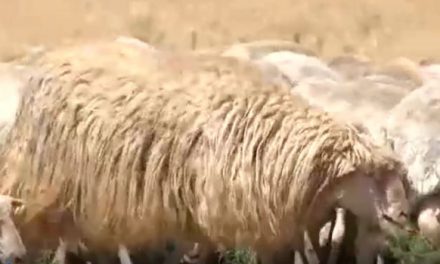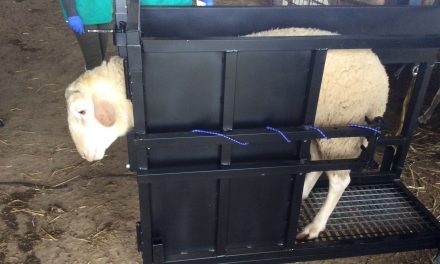This post is also available in:
![]()
![]()
![]()
![]()
![]()
Country: Italy
Dairy or/and meat sheep: both
Source of information: http://www.sardegnaagricoltura.it/documenti/14_43_20131114135122.pdf
Level of solution: Practical
Aim: Improving the fertility and concentration of lambings
Description:
What and How to do: Application system:
-
- Step 1 Isolation of males from females in a separate pen (far from sight, hearing and smell) for at least 8 weeks.
- Step 2 (Day 1) Rams introduction (no shearing) (1Male/20Female) 17-20 days before mating.
- Step3 (Day 10) Sharing according to weather
- Step4(Day14-16) Organization of the mating group (4-6Male/100 Females). In the case of controlled natural mating with just one ram, it is suggested to use the teaser rams with marking crayon or use small mating groups with 1M/20F.
- Step5 (Day 17-18) Put marking crayon in rams to better control mating behavior.
- Step6-(17-25) Starting of the heat and mating days.
When to do: The ram needs to be introduced according to the reproduction plan (May-June) in the Mediterranean region, the ram removal should be done at the end of the reproduction season (July) for adult ewe and (November – December) for ewe-lamb (Dairy sheep management).
Expected benefits: Increasing fertility rates and concentration of lambing
Prerequisites and/or limits
Suffcient manpower to manage groups
Areas for male isolation.
Sufficient number of males.
Teaser ram for farms of the selection program
Increased costs of males management
more information on Booklet “ram management” AGRIS-ARA
References
Dattena, M., & Mayorga, I. (2011). Innovative biotechnologies of reproduction on sheep management. Options Méditerranéennes. Séries A. Mediterranean Seminars, (97), 89–94.
Cox, J. F., Jeria, E., Bocic, A., Vera, N., Soto-Saravia, R., & Dorado, J. (2015). Characterization of the productive performance of Highlander sheep in Southern Chile. II. Male reproductive traits. Small Ruminant Research, 130, 189–192. https://doi.org/10.1016/j.smallrumres.2015.07.004
Van Metre, D. C., Rao, S., Kimberling, C. V., & Morley, P. S. (2012). Factors associated with failure in breeding soundness examination of Western USA rams. Preventive Veterinary Medicine, 105(1–2), 118–126. https://doi.org/10.1016/j.prevetmed.2012.02.002
Dattena, M., Mayorga, I., Mara, L., Gallus, M., Meloni, G., Cabiddu, A., … Dattena M et al. (2012). An example of reproduction management in organic sheep farming. In EAAP Scientific Series (Vol. 131, pp. 223–227). https://doi.org/10.3920/978-90-8686-741-7_27 LB – Dattena2012
Dattena, M., Mara, L., Falchi, L., Meloni, G., Facchin, F., & Gallus, M. (2012). Artificial Insemination and Reproduction Management in small ruminants with special regard to future perspectives. EAAP European Association Animal Production.
Gouletsou, P. G., & Fthenakis, G. C. (2010). Clinical evaluation of reproductive ability of rams. Small Ruminant Research, 92(1–3), 45–51. https://doi.org/10.1016/j.smallrumres.2010.04.005
Scaramuzzi, R. J., Oujagir, L., Menassol, J. B., Freret, S., Piezel, A., Brown, H. M., … Fabre Nys, C. (2014). The pattern of LH secretion and the ovarian response to the “ram effect” in the anoestrous ewe is influenced by body condition but not by short-term nutritional supplementation. Reproduction, Fertility and Development, 26(8), 1154–1165. https://doi.org/10.1071/RD13139
Tips & Tricks
Measuring tape to assess the testicular perimeter of rams
Expected impacts
|
Stakeholder Perception for Implementation of Solutions |
|||||||||
|
1. Level End-User Assessment (Partner) |
|||||||||
|
Country |
Italy |
||||||||
|
Partner |
Agris |
||||||||
|
Topic |
Reproduction |
||||||||
|
Issue |
ram management |
||||||||
|
Solution No/Name |
15 – Optimized use of rams |
||||||||
|
Service provider/technicians+vet or farmers |
farmers |
||||||||
|
Benefit |
|||||||||
|
Benefit expected |
fertility |
|
|||||||
|
System |
|||||||||
|
Is the solution suitable for various production systems |
Yes |
all types define in the first survey |
|||||||
|
If no – for which system |
|
|
|||||||
|
Cost |
|||||||||
|
What are the asset costs |
materials to manage rams |
<100 |
|||||||
|
What are the maintenance costs |
materials to manage rams |
50-100 |
|||||||
|
Any limits to its applicability |
Sufficient manpower to manage groups, facilities for male isolation, sufficient number of males |
||||||||
|
Work Load |
|||||||||
|
|
Farmers |
Service provider/tech.-vet-others |
|||||||
|
How much time is required to prepare and implement the solution |
learning of the procedure |
1 day – 1 week |
|||||||
|
How many people is needed to implement the solution? |
depend on farm organisation |
|
|||||||
|
Timing |
|||||||||
|
How long it takes to get results? |
2 months |
||||||||
|
How long it takes to see an effect on sheep productivity? |
next production period
|
||||||||
|
Equipment/Facility |
|||||||||
|
|
Farmers |
Service provider/technicians-vet-others |
|||||||
|
What kind of equipment/tool are necessary? |
|
|
|||||||
|
Skill/Knowledge-Training (farmer) |
|||||||||
|
Does the solution need any specific skill/knowledge or training? |
learning of the procedure |
||||||||
|
How much time will be required for training |
1 day |
||||||||
|
Wider Environment |
|||||||||
|
Is there any particular regulation link to the solution? |
|
||||||||
|
Does the solution need any particular structure or organisation? |
|
||||||||
Users’ evaluation:
|
Country |
Spain- EAGROUP, COVAP, MSD |
|
|
Solution No/Name |
A12- Ram management during reproduction season |
|
|
Farmer/Service provider/technicians-vet-others |
F |
A |
|
Why did you select this solution? |
Low fertility and need to increase the economic profitability of the activity |
|
|
Was it easy to implement? |
more or less |
|
|
If not say what are the identified drawbacks? |
Rams in the flock are usually the forgotten ones |
|
|
Did you need to adapt it? |
Yes |
|
|
If yes, how? |
Homogenize the classification criteria |
|
|
Were you happy with the outcome of the solution? |
Yes |
|
|
What were the outcomes? |
Culling old males (>5 years-old) Cull between 13-18% of rams due to poor seminal quality The fertility of the batch varies depending on the number of non-valid rams used: 0 infertile rams ………..85% fertility of the batch 1 infertile rams………..67% fertility of the batch 2 infertile rams……….. 61% fertility of the batch |
|
|
Score the solution |
Interesting but needs adaptations to be better implemented (minimum requirements for the rams) |
|
|
Will you continue to implement it? |
Yes |
|
|
If not, for which reasons? |
|
|
|
Comments/Additions |
The first evaluation must be at least when rams are 8 months old. Seasonal variations in the testes size and seminal quality require in some males the implementation of 2 analysis. Cold weather conditions in the field may generate doubts about the result of the evaluation of sperm quality. |
|







